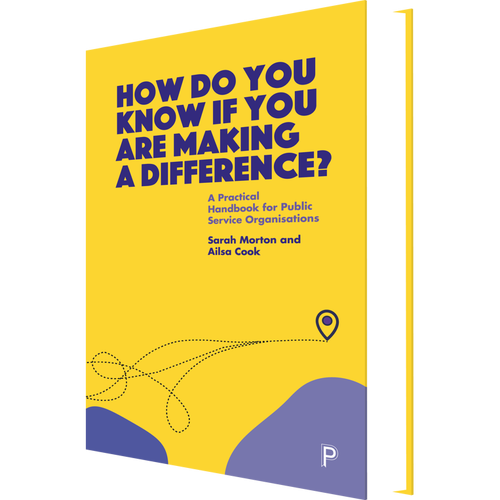On this page you will find links to the resources and support mentioned in the webinar plus a summary of Sarah’s answers to the questions asked, including those she didn’t have time to answer! If we’ve missed one, or another question comes to mind – please click ‘leave feedback or ask a question’.
Thanks again for joining us live or on catch-up. Make sure you’re signed up to receive our emails if you want to hear about future webinars.
Webinar resources
-
What do you need to track the impact of research? View our summary infographic
-
Research impact vision at institutional level – view the template outcome map
We’re here to help you and your institution with research impact strategy, planning and assessment
We offer consultancy, training and software to help you plan for and track the impact of research, knowledge mobilisation and evidence to action initiatives.

The questions you asked
In non-academic or research organisations, how do you convince others that high-quality research is essential to impact, not just how it’s communicated? I feel the charity sector, especially smaller charities, can struggle with the need for evidence beyond anecdotes and service users.
Absolutely. It’s about the cultural aspect, isn’t it? If relationships between universities and charities were more nurtured and sustained, providing mutual benefits, then the necessity of high-quality research would be more apparent. Universities working closely with charities ensure that high-quality research is relevant and accessible, aiding in understanding and building on their work. Leadership needs to value research and convey its importance throughout the organisation. It requires a strategic approach, not just individual efforts.
When working in a rapid context with limited resources, how do we effectively measure impact, particularly within the charitable context?
We’ve done extensive work on this, and we have resources available, such as our book How Do You Know You’re Making a Difference and related webinars. The key is to set out your pathway to impact and ensure continuous assessment or reflection as you deliver your work. For more detailed guidance, please refer to our resources or get in touch with us directly.
How do we get senior leaders on board with measuring impact?
Connecting back to the vision and purpose is crucial. In our workshops, we find that reminding leaders of their core mission helps them see the importance of measuring impact. Our book might be helpful here as well. It’s about aligning impact measurement with the organisation’s values and goals.
What methods, processes, or systems work best for managing stakeholder relationships across a large organisation or university?
The best tool for this is a customer relationship management (CRM) system, although they can be expensive. It’s important to centralise engagement records and ensure appropriate stakeholders are consulted. Spreading the reach beyond a few favourite organisations and consistently updating stakeholder mapping in your CRM is crucial.
If you’re developing institutional strategy in addition to departmental impact strategies, which should you do first?
Start with the institutional strategy. Departments need to align with the institution’s offerings and requirements. Drafting a departmental strategy can sometimes push for an institutional strategy, but ultimately, institutional guidance is essential for coherence and effective implementation across departments.
As a researcher mostly linked to individual projects with limited durations (e.g., three years), how do you ensure effective mobilisation towards system change?
Begin each project by defining a vision for impact and mapping out a pathway to impact. Consider the contextual drivers and involve a research advisory group to understand wider issues. Regularly review your strategy to align with emerging opportunities and changes in the broader context, even beyond the project’s duration
In the research programme I work for, we support a lot of researchers conducting fundamental research. How can we ensure they engage in research impact pathways?
We get asked this question a lot. In our training workshops we often have groups of people with different research focuses and some of them can be so far from impact it’s hard for them to envision it.
Our advivce is to engage researchers by discussing the long-term contributions of their work. Even if immediate impact seems distant, understanding the potential future impact can be enlightening. Encourage units to consider impact pathways collectively rather than individually, fostering a broader perspective on impact within the research community.
How can we evaluate the impact of Equality, Diversity, and Inclusion (EDI) strategies beyond diversity data collection?
Set out a pathway to impact that explains the purpose of your EDI strategy. Collecting data is just one part; you need to link it to your broader strategy. Evaluate the outcomes and impacts of the actions taken based on the data, ensuring that the strategy’s goals are met.
How do we keep postgraduates curious and thinking out of the box when a structured model of (societal) impact is increasingly driving research?
Encourage postgraduates to engage with at least one organisation outside their institution. This external interaction can provide new perspectives and foster long-term relationships that enrich their research. It’s about bridging the gap between academic research and real-world applications. Some of these early connections might last across their careers.
What have you found effective for a charitable funder one step removed from the activities driving change? How would you tweak the approaches/contribution analysis to apply to a trust/foundation?
We’ve worked with funders by creating outcome maps with funded projects sharing similar outcomes. Each project tracks its impact against this map, allowing us to see both individual and collective contributions to the funder’s goals.
Have you ever encountered commercial organisations that employ new technology, increase profits as a result, but want to keep their cards close to their chest and not acknowledge academic input? Is this an impasse you recognise, and what can be done?
Another webinar participant shared her experience in the chat in response to this question, noting that after building relationships, including with legal teams, some organisations were willing to share information confidentially for REF purposes only. Building trust and clear agreements can help in these situations.

Co-authored by Matter of Focus Directors Sarah Morton and Ailsa Cook, and published by Policy Press, this practical handbook pulls together the Matter of Focus approach; drawing on everything they have learned from working with more than 180 organisations and sharing some stories of our pioneering clients.